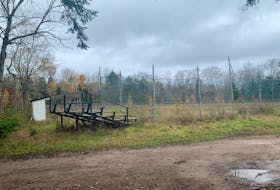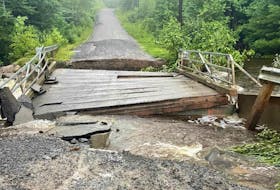MIDDLETON – Ron Taylor stands in the DOT shed, a row of snowplows lined up behind him.
Guys are doing last-minute checks on the big trucks. They carry wrenches, inspect lights, top off fluids, double check everything.
There’s a big storm on the way. The drivers, mechanics, and managers have been preparing for a couple of days and by 10 a.m. the first flakes are falling.
“For the last three days we’ve been watching the weather and preparing,” Taylor said. “Yesterday the temperatures came up. Our policy is minus seven at night, minus 10 during the day to salt, so we were able to actually break clear the crust that built up on the road over the last few days due to cold. By doing that, what we’re doing is we’re setting a new bond to keep the snow from sticking.”
Maintenance-wise they’ve been double-checking plows, pins, hydraulic lines. Crews are also checking to make sure any parts that normally wear through in an ice- or snowstorm are in good condition or are replaced. They purchased extra fuel. They even have chainsaws. Last week they were bringing more salt in to prepare for the storm.
Everything is in place.
“We’ve made our connections with EMO, Nova Scotia Power, EHS. They all have our supervisors’ contacts,” Taylor said. “We have their contacts for being able to communicate during the storm.”
Taylor walks around the plows pointing out the work being completed.
“The guys are just touching up what hasn’t been done, but today the big emphasis is gearing up the trucks to make sure everything is in place. Everything’s ready to be dispatched at a moment’s notice.”
Fluids are being checked on one truck. Lights are being tested. It’s 9:30 a.m. and there’s not much left to do but wait.
The Gear
“This type of a storm everything will be dispatched,” Taylor said. “There’s five tandems that will be dispatched out of this one base; two graders and a loader.”
Plus they’ll hire two two loaders from private contractors that will be dispatched at the same time.
“The biggest thing right now is to get that bond down prior to the storm and the road covering.”
When the storm becomes severe they’ll work from a set of priorities that insures NSP can get to where they need to be, makes sure that EHS, ambulances, and hospital have accessibility. The service levels puts Highway 101 first, Trunk 1 second, and routes third.
The applications they use are several and are applied before during and after a storm.
“We typically try to brine the road … anywhere from 12 to eight hours prior to the storm, to create a bond to keep the snow from sticking,” he said. “After that we go into salt mode once the snow starts to cover the roads, but then again -10 road temp during the day, -7 at night road temperature, after those temperatures the salt loses its effectiveness and we’d create a bigger hazard, so we switch to sand.”
Based out of Middleton is a direct liquid application tanker that’s dispatched for Highway 101 and goes from Weymouth to Avonport, spraying brine in three counties. Another tanker brines from Weymouth to Yarmouth.
Geography
The geography of the Valley makes clearing roads different every kilometer you go, Taylor said.
“Digby, Lequille, and Middleton – those three areas – have three totally different climates most of the time. In Digby when you cross the Bear River Bridge to the Lequille side, the temperature is usually one to two degrees cooler, and you’ll see that that’s where we’ll have the large signs in place on the 100 series saying ‘winter conditions.’ You’ll also find them on the west end of Bridgetown on the 101 stating the same. That’s our highest point so our temperatures can be two to three degrees colder. And that’s generally where we’re going to end up with flurries when it’s fine everywhere else.”
And then there are ‘bay flurries’ that come from the north.
“We can end up with bay flurries that last up to four to five days with accumulations of 10 to 15 centimetres at times where further east, Aylesford-Berwick area, they’re not always receiving those snow falls,” he said. “And the road temperature itself is usually one to two degrees warmer in that area. And traffic volume? Traffic volume is the biggest thing. The larger the traffic volume the more effective your salt becomes.”
The Area
Taylor is operations supervisor in charge of the Middleton, Lequille, and Digby bases.
“We try to stay consistent,” he said. “We’ve actually taken it a little further this year. When we decide to salt or sand, or vice-versa, we’re actually in contact with Bridgewater and Berwick who also contact us when they’re going out. We compare temperatures and then we try to have the conditions the same all they way through. But unfortunately because of different climates that’s not always possible, but that is the goal we try to meet.”
Taylor said routes are pre-planned and the application rates of salt, brine, and sand for those routes are set out on the trucks’ computers.
“The routes are actually designed to get you from point A to point B and back before you run out – with extra,” he said. “They come back and reload and get out again.”
His crews have eight hours after the end of the storm to have 100 series highways cleared. Trunk 1 and routes they have 12 hours to be bare, and for local paved roads they have 24 hours after the snow has completely stopped to have it centerline bare.
The Hours
Driving a plow is not a simple job. From Dec. 2 to March 30 they have 24-hour crews, seven days a week.
“These guys are scheduled for seven days a week if needed,” Taylor said. “If they have a shift it’s from 5 a.m. to 5 p.m. or 5 p.m. to 5 a.m. and they have to be available one hour prior to their shift, ready to go.”
For many, particularly the grader and loader operator, the cabs of their trucks become their lunch rooms and offices. They don’t get out except to fuel, add chains, or do repairs.
“Other than that they don’t come back to the shed to a warm comfortable office or lunch room to have a break,” he said. “The radio’s constantly going and that’s their office for 12 hours.”
If the plow hasn’t been by your house, Taylor suggests people can get on their computers and follow Plow Tracker at https://novascotia.ca/tran/winter/plowtracker.asp








